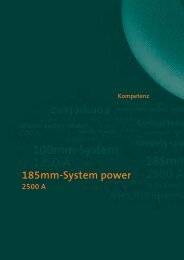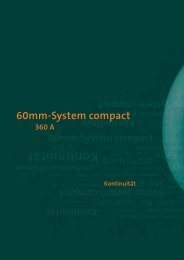- Page 1 and 2: Product manual 2013English
- Page 3 and 4: wöhnervision - the Wöhner magazin
- Page 5 and 6: DEAR READERS, All over the world, t
- Page 7 and 8: 2963 METRES is the height of the Zu
- Page 9 and 10: BAD ESSEN OSNABRÜCK SIEGEN BIRKENH
- Page 11 and 12: 2012 Wöhner presents its latest in
- Page 13 and 14: GEOTHERMAL MADE IN GERMANY THE SUST
- Page 15 and 16: THE CAR BEER The German purity law
- Page 17: ROBERT BOSCH The electrical enginee
- Page 21 and 22: GIESECKE & DEVRIENT NAUF BURDA FABE
- Page 23 and 24: MADE IN GERMANY THE LITERARY DUET W
- Page 25 and 26: MADE IN GERMANY FORMS IN MOTION It
- Page 27 and 28: 43% is the alcohol content of the s
- Page 29 and 30: Editorial information EDITORIAL INF
- Page 31 and 32: New from Wöhner. Global control of
- Page 33 and 34: AMBUS®EasyLiner PV 1000V DC fuse h
- Page 35 and 36: 1 2 3 4 5 6 7 8 9 10 60mm-System co
- Page 38 and 39: System advantages With an installed
- Page 40 and 41: 1/1 60mm-System compact, 3-pole, sy
- Page 42 and 43: 1/3 60mm-System compact, 3-pole, sy
- Page 44 and 45: 1/5 60mm-System compact, 5-pole, sy
- Page 46 and 47: Know-how
- Page 48 and 49: System advantages The 60mm busbar s
- Page 50 and 51: 2/1 01 485 01 131 01 484 01 356 01
- Page 52 and 53: 2/3 01 232 01 422 01 231 01 132 01
- Page 54 and 55: 2/5 60mm-System classic 630A (800A)
- Page 56 and 57: 2/7 01 071 01 070 01 069 01 759 01
- Page 58 and 59: 2/9 01 907 01 906 01 185 01 047 01
- Page 60 and 61: EQUES®MotorController 2/11 with re
- Page 62 and 63: 2/13 32 477 32 486 32 464 32 485 32
- Page 64 and 65: EQUES®PowerConnector 2/15 32 157 3
- Page 66 and 67: 2/17 36 209 36 108 36 105 36 102 36
- Page 68 and 69:
2/19 31 158 01 981 01 424 01 980 01
- Page 70 and 71:
2/21 31 963 31 955 31 958 31 960 31
- Page 72 and 73:
2/23 CrossLink® Technology, module
- Page 74 and 75:
2/25 CrossLink® Technology, module
- Page 76 and 77:
2/27 33 156 33 914 33 908 33 911 Ac
- Page 78 and 79:
2/29 33 063 33 602 33 601 QUADRON®
- Page 80 and 81:
Accessories for QUADRON®CrossLinkB
- Page 82 and 83:
2/33 SECUR®LeanStreamer size 00, N
- Page 84 and 85:
System components 4-pole 2/35 31 96
- Page 86:
Expertise 185mm-System power 2500A
- Page 89 and 90:
The universal busbar support allows
- Page 91 and 92:
3/2 33 341 01 906 01 907 01 185 01
- Page 93 and 94:
3/4 33 097 33 099 33 093 33 095 33
- Page 95 and 96:
3/6 33 126 33 292 33 300 33 373 Acc
- Page 97 and 98:
3/8 185mm-System power 2500A 3 8
- Page 99 and 100:
3/10 SECUR®LeanStreamer size 00, N
- Page 101 and 102:
Safety 4
- Page 103 and 104:
Centre feed unit up to 4000A Centre
- Page 105 and 106:
4/2 CRITO®PowerClip, brace termina
- Page 107:
4/4 Centre feed unit up to 4000A 4
- Page 110 and 111:
For conventional wiring, Wöhner of
- Page 112 and 113:
5/1 31 971 31 973 31 555 31 548 AMB
- Page 114 and 115:
5/3 03 290 03 288 03 289 03 294 03
- Page 116 and 117:
5/5 31 286 31 288 31 014 TRITON® 3
- Page 118 and 119:
5/7 31 110 31 123 31 273 31 258 AMB
- Page 120 and 121:
31 014 Accessories 5/9 31 012 01 19
- Page 122 and 123:
5/11 31 295 31 296 31 297 31 298 AM
- Page 124 and 125:
5/13 03 351 03 760 79 449 79 448 NH
- Page 126 and 127:
Panel-mounting components Switchgea
- Page 128 and 129:
QUADRON®CrossLinkBreaker Disconnec
- Page 130 and 131:
MOTUS®ContactronControl 6/1 36 209
- Page 132 and 133:
QUADRON®CrossLinkSwitch 6/3 33 552
- Page 134 and 135:
QUADRON®CrossLinkBreaker NH fuse s
- Page 136 and 137:
6/7 33 142 33 418 33 155 33 154 Acc
- Page 138 and 139:
CAPUS®EasyUse 6/9 33 336 33 352 33
- Page 140 and 141:
CAPUS®EasyUse 6/11 33 928 33 449 3
- Page 142 and 143:
CAPUS®EasyUse 6/13 33 937 33 470 3
- Page 144 and 145:
CAPUS®PowerFuse 6/15 33 340 33 352
- Page 146 and 147:
Network
- Page 148 and 149:
MOTUS®ContactronControl 7/1 36 111
- Page 150 and 151:
7/3 01 138 33 075 01 890 01 888 01
- Page 152 and 153:
01 127 7/5 01 114 01 928 08 824 08
- Page 154 and 155:
7/7 01 196 01 612 01 613 01 298 01
- Page 156 and 157:
D0 fuses as per DIN VDE 0636-3 / IE
- Page 158 and 159:
NH fuses as per DIN VDE 0636-2 / IE
- Page 160 and 161:
31 185 Cylindrical gG fuses Fuse li
- Page 162 and 163:
31 209 Cylindrical gG fuses Fuse li
- Page 164 and 165:
31 252 Cylindrical class CC fuses F
- Page 166 and 167:
7/19 31 353 31 363 03 231 03 236 Cy
- Page 169 and 170:
Technical data Research 8
- Page 171 and 172:
Note on operating NH fuse switch di
- Page 173 and 174:
CE marking Wöhner products are sub
- Page 175 and 176:
Busbars, in compliance with EN 1360
- Page 177 and 178:
Universal conductor terminals Unive
- Page 179 and 180:
Clip-on screw connector The clip-on
- Page 181 and 182:
EQUES®EasyConnector EQUES®MotorCo
- Page 183 and 184:
MOTUS®ContactronControl Compact mo
- Page 185 and 186:
SECUR®PowerLiner, bus-mounting fus
- Page 187 and 188:
D02 bus-mounting fuse base, CUSTO®
- Page 189 and 190:
AMBUS®PowerSwitch, disconnectors w
- Page 191 and 192:
AMBUS®EasySwitch Class CC, Holder
- Page 193 and 194:
QUADRON®CrossLinkCarrier, NH fuse
- Page 195 and 196:
QUADRON®CrossLinkBreaker, QUADRON
- Page 197 and 198:
Conductor connections: Size Screw C
- Page 199 and 200:
QUADRON®CrossLinkSwitch NH busbar-
- Page 201 and 202:
QUADRON®CrossLinkSwitch Bus-mounti
- Page 203 and 204:
NH Bus-Mounting Fuse Block 690V ˜
- Page 205 and 206:
Technical specifications Size 1 2 3
- Page 207 and 208:
CAPUS®EasyUse Switch Disconnectors
- Page 209 and 210:
To IEC/EN 60947-3 800A 1250A 1600A
- Page 211 and 212:
Short-circuit withstand capacity di
- Page 213 and 214:
Short-circuit strength diagrams acc
- Page 215 and 216:
Part no. Rated operating Voltage U
- Page 217 and 218:
Part no. Rated operating Voltage U
- Page 219 and 220:
Part no. Rated operating Voltage U
- Page 221 and 222:
Part no. Rated operating Voltage U
- Page 223 and 224:
Part no. Rated operating Voltage U
- Page 225 and 226:
Part no. Type no. USA 01 240 240-L
- Page 227 and 228:
Part no. Type no. USA 03 228 03 229
- Page 229 and 230:
Part no. Type no. USA 31 353 31 354
- Page 231 and 232:
Part no. Type no. USA 32 969 32 973
- Page 233:
Approvals 8 64
- Page 236 and 237:
01 272 01 068 01 203 01 284 01 285
- Page 238 and 239:
01 364 01 367 01 370 01 426 01 427
- Page 240 and 241:
01 495 01 485 01 484 01 500 01 357
- Page 242 and 243:
01 116 01 231 01 236 01 237 01 238
- Page 244 and 245:
01 539 01 540 01 596 a b c 180 146
- Page 246 and 247:
01 068 01 203 01 284 01 285 01 287
- Page 248 and 249:
32 429 32 430 32 431 32 432 32 433
- Page 250 and 251:
32 137 32 138 32 140 32 156 32 157
- Page 252 and 253:
03 520 03 518 33 402 33 421 33 422
- Page 254 and 255:
03 654 03 656 33 216 a b c d e x 03
- Page 256 and 257:
33 160 33 161 33 162 33 325 33 326
- Page 258 and 259:
33 910 33 911 33 510 33 511 33 516
- Page 260 and 261:
NH fuse switch disconnector with el
- Page 262 and 263:
01 034 01 092 01 206 01 207 01 218
- Page 264 and 265:
33 235 33 236 33 087 33 088 33 089
- Page 266 and 267:
31 286 31 293 31 173 31 175 31 176
- Page 268 and 269:
31 115 - 31 119 31 135 - 31 138 31
- Page 270 and 271:
33 409 Centre line of connection a
- Page 272 and 273:
03 350 03 351 03 354 03 355 03 749
- Page 274 and 275:
33 149 33 150 33 151 33 201 33 202
- Page 276 and 277:
33 502 33 542 33 505 33 545 33 910
- Page 278 and 279:
33 333 33 334 33 335 33 336 33 424
- Page 280 and 281:
33 430 33 431 33 432 33 433 33 434
- Page 282 and 283:
33 437 33 438 33 439 33 452 33 453
- Page 284 and 285:
33 458 33 459 33 460 33 461 33 462
- Page 286 and 287:
05 779 05 780 05 781 05 782 05 783
- Page 288:
Appendix Co-operation
- Page 291 and 292:
Terms of Sale and Delivery 3. Tool
- Page 293 and 294:
Terms of Sale and Delivery IX. Othe
- Page 295 and 296:
Part no. Amount Amount of copper of
- Page 297 and 298:
Part no. Amount Amount of copper of
- Page 299 and 300:
Part no. Amount Amount of copper of
- Page 301 and 302:
Part no. Amount Amount of copper of
- Page 303 and 304:
Part no. Amount Amount of copper of
- Page 305 and 306:
Part no. Amount Amount of copper of
- Page 307 and 308:
Wöhner-Group worldwide Worldwide b
- Page 309 and 310:
Wöhner-Group worldwide Malaysia Pe
- Page 311 and 312:
Wöhner-Group Europe Europe-wide br
- Page 313 and 314:
Wöhner-Group Europe Republic of Be
- Page 315 and 316:
Representatives in Germany 03 Ingen
- Page 317:
Notes Notes 10 28
- Page 320:
Woehner (UK) Limited · Electrotech


![phb2013_complete_en.pdf [18.3 MB] - Wöhner](https://img.yumpu.com/12655320/19/500x640/phb2013-complete-enpdf-183-mb-wahner.jpg)









![phb2013_08_en.pdf [1.25 MB] - Wöhner](https://img.yumpu.com/12655318/1/184x260/phb2013-08-enpdf-125-mb-wahner.jpg?quality=85)



![phb2013_deu_05.pdf [4.32 MB] - Wöhner](https://img.yumpu.com/12655312/1/184x260/phb2013-deu-05pdf-432-mb-wahner.jpg?quality=85)